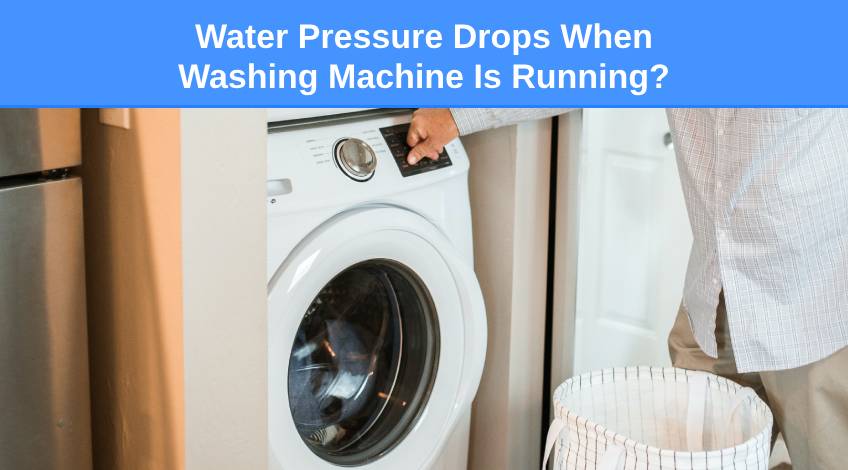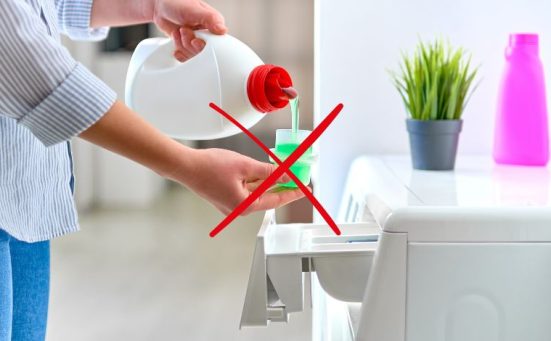
Water Pressure Drops When Washing Machine Is Running? (here’s why & what to do)
If you have noticed that the water pressure in your home drops when the washing machine is running making it impossible to have a shower or wash the dishes, keep reading.
In this article we take a close look at the reasons why the water pressure might drop when the washing machine is being used as well as offering some solutions to this problem.
Why Does The Water Pressure Drop When The Washing Machine Is Running?
There are a number of reasons for the water pressure to drop when the washer is running which include;
| Probable Cause | Solution |
|---|---|
| Someone Is Using Water Elsewhere In The Home | Ensure that all other taps are off until the washer has filled up |
| Water Inlet Issues | Check the inlet hose and inlet screen |
| Blocked Filter | Check and remove any blockages |
| Stopcock Not Fully Open | Check and fully open the stopcock |
| Water Pipe Leaks | Contact a plumber |
| Main Water Valve Not Fully Open | Check and fully open the main water valve |
| Low Mains Water Pressure | Contact your local water authority |
Let’s take a look into each of these in more depth now:
Someone Is Using Water Elsewhere In The Home

If someone is using a tap elsewhere in your home when the washing machine is running, this could cause a problem. Especially if your home suffers from lower than average water pressure.
As this is typically only a problem during the first 10 minutes or so of the washer’s cycle, try not using any taps until the washer has filled with water.
Check all other taps, showers, garden hoses, etc and ensure they are turned off until the washer fills with water. Every additional demand for water will add to the low pressure, ensuring everything else is off will help the washer complete its cycle.
Water Inlet Issues
There are a number of places on the water inlet system of the washing machine that could be causing this issue. They include;
Twisted Inlet Hose
All of the water that enters the washing machine comes in through the inlet hose. If the inlet hose becomes twisted or kinked, it will restrict the flow of water and take longer to fill the machine.
Inlet Screen
Inside the inlet hose, where it connects with the inlet valve, there is a small mesh screen or filter. This is there to prevent any grit that might be present in the water from blocking the inlet valve.
Over time this screen can become clogged or partially blocked with grit or limescale. To access this screen you will need to remove the inlet hose after turning off the water supply to the washer.
Once the inlet hose is off, look inside the lug on the washer and you will see a small plastic screen that can be removed using a pair of long-nosed pliers. You can then gently wash the screen and remove any blockage.
Take care as the screen is quite fragile and can easily be damaged.
Blocked Filter

The filter on a washing machine is there to trap any items that could cause damage to the components. Items like;
- Keys
- Nails
- Screws
- Buttons
- Lint
- Material
Any one of these or a combination could cause the filter to become blocked and impede the fill time of your washer. Consult your user manual for the location of the filter (typically at the bottom front of the machine) and remove it.
It’s a good idea to place a towel on the floor to soak up any water that escapes when the filter is taken out. If possible place a shallow tray or bowl to catch any stray water as well.
Once the filter is out, wash it under a fast running tap and remove any debris. Whilst the filter is out, check the impeller inside the filter housing and using a finger ensure the impeller turns freely.
Then replace the filter and ensure it is tightened up correctly to prevent leaks.
Stopcock Not Fully Open
If you have recently had some plumbing work done in your home, it’s possible that the plumber never fully opened the stopcock. This could be the reason why the water pressure is low and the washer doesn’t fill in its allotted time.
Locate the stopcock (typically under the kitchen sink) and ensure it is fully open. This could be all that’s needed to solve the low water pressure issue.
Water Pipe Leaks
A more serious issue would be that one of the water pipes that supplies your home with water has developed a leak. You might notice patches of damp on walls or ceilings but this is not always caused by a leaking pipe.
However, if you suspect that one of the water pipes supplying your home with water is leaking, you need to contact a plumber immediately.
Main Valve Is Not Fully Open
Outside your home you should see a small oblong metal flap. The main water valve for your home is usually located under this flap.
Lift the flap and check that the valve is fully opened. This could be enough to increase the water pressure entering your home.
Low Mains Water Pressure
Your washing machine needs a water pressure of at least 20 psi (pounds per square inch) to run properly. You can check if the water supplied to your home is of sufficient pressure.
All you need to do is fill a 1 gallon (4.5 litre) bucket with water from the cold tap in your kitchen and time it. If it takes 30 seconds or less, the water pressure coming into your home is sufficient.
Any longer than 30 seconds and the pressure is insufficient and you’ll need to contact your local water authority.
If All Else Fails, Fit A Booster Pump
A water booster pump increases the water pressure and volume of water to a particular area of your home. The booster pump uses an impeller to force water to flow at a faster rate through the water pipes in your home.
There are various types of booster pumps available and they can be used to boost all water supplies, even well water. Talk to your plumber if low water pressure is a problem and you think a booster pump will help.
Why Did My Old Machine Work Fine With Low Water Pressure?

Now that we have looked into the causes of low water pressure in your home, let’s say a few words about why this has only just become a problem.
Older Washing Machines
You see, older washing machines were controlled using mechanical timers which didn’t click in until the washer was filled with water. Everything else related to the wash programme stopped until the pressure sensor detected enough water present to start the cycle.
At that point, power was sent to the timer and the washer began washing the laundry. As this system wasn’t reliant on time, it could tolerate low water pressure. All it needed to do was wait until the correct amount of water was present in the appliance.
Modern Washing Machines
Modern washers don’t have a timer and are controlled by software which is built into the PCB (Printed Circuit Board). The wash cycle is controlled in much the same way as a program is on your PC or laptop.
This is a good thing overall as it provides excellent safety features and energy and water efficient features. However, there is one drawback, which is that without a high enough water pressure, many modern washers will detect a fault and stop the cycle.
This can happen even if the new machine is connected to the same fittings as the old model.
The amount of time set for the water to fill the modern machine can vary from appliance to appliance. Some will allow for a slower fill due to low water pressure whilst others will just cancel the programme after a set time (typically 10 minutes).
Modern machines use these preset timings to prevent any potential damage to your home due to water leaks etc. Plus the washer needs a certain level of water pressure to operate correctly.
The fill valve, for example, needs a minimum water pressure to shut off properly. If that water pressure isn’t maintained, water can continually drip into the drum.
SEE ALSO: Are Smart Washing Machines Worth It?
Frequently Asked Questions
Water pressure does affect the washing machine. If the water pressure is too low it can lead to the machine shutting down and cancelling the cycle.
In some cases, when the washing machine is filling with water, it can affect the water pressure in the shower. Or the shower can prevent the washer from filling correctly. However, if your home has a good water supply at a decent pressure this shouldn’t be a problem.
Old washing machines used a mechanical timer that didn’t kick in until the water had successfully filled the drum. Modern machines use electronic timers that start as soon as the cycle is selected and the start button pressed. This means that if the water pressure is low, a modern machine will cut out before the drum has time to fill.
Also, follow us on Pinterest ...



